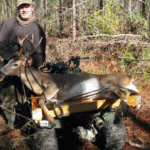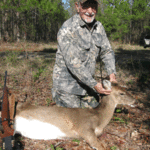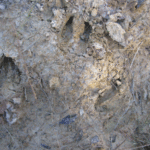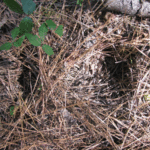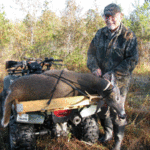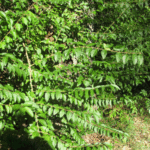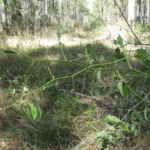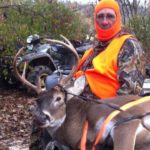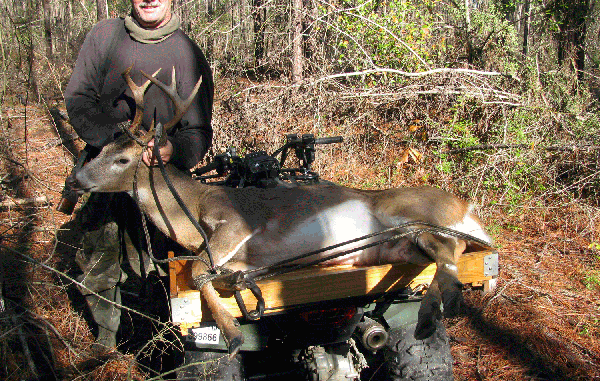
This late in the season, pieny woods deer often ignore food plots — at least during the daytime. But make a subtle change, and the results could be deer on the ground.
Da Saints had just stomped Da Falcons in Da Dome. Da Tigers were scheduled to stomp Bama at the championship the following week. And a perfectly-timed (for hunting) holiday cold-front was barreling through.
So spirits were soaring high at Da Camp as we converged the day after Christmas, with Da owners Eddie and Artie arriving elegantly late, as usual.
Exactly which one of Dem owned and ran the deer-club had never been precisely nailed down. Artie’s uncle more or less “founded” Da Lease back around the time “Bum” Phillips resigned as Saint’s coach in a huff.
But during Da Depression, Eddie’s grandfather had bought up much land “across da lake” (remember, the term “Northshore” only came into vogue about a decade ago) and donated 300 acres to their cousin Artie’s lease about the time Jim Mora resigned as Saint’s coach in a huff.
This “generosity” (actually the land had been declared wetlands by the feds, and the planned development became a gigantic hassle with mitigation, etc.) gave Eddie certain “privileges” utterly unknown to the club’s founding rank and file. These privileges included granting “honorary” memberships to Pelayo and me, who started hunting it regularly about the time Mike Ditka resigned as Saints’ coach in a huff.
Granting honorary membership into this Florida Parish “club” to this notorious riffraff bumped back many distinguished and deserving applicants on the club’s waiting list. At a now-famous club meeting, this disgusting act of shameless favoritism caused three founding members to promptly resign in a spittle-spewing huff, complete with door-slams.
If you recall the face and mannerisms of Jack Woltz as he explained to Corleone consigliere Tom Hagen why Johnny Fontaine would NEVER (!!!) get a part in his movie, you’ll spare me from attempting to describe the faces and mannerisms of those who resigned. If you recall Sonny Corleone’s face when he got the call from Connie that Carlo was slapping her around — you’ll spare me from attempting to describe the faces of those on the waiting list. If you recall Tony Montana during the last 15 minutes of Scarface, you’ll imagine what they craved to inflict on the entire club — especially the two usurpers.
This peculiar ownership and membership arrangement makes for many lively “discussions,” especially if Artie’s losing big at the Bourré table and compensating with slugs of blackjack in his trademark Big Gulp cup.
But this weekend wasn’t one of them.
“No problemo!” Artie laughed and waved while dealing out another hand at the Bourré table. “Zack’s (Pelayo’s cousin in from Atlanta) is welcome to hunt my stand tomorrow.”
“Mine on the power line’s gonna be open, too,” added Spencer as he grabbed his cards. “Zack is welcome to it.”
“My but aren’t we generous this weekend?” a wide-eyed Eddie laughed while looking around. After all, Pelayo’s “guest-inviting” privileges (anyone he wants, anytime he wants) also provokes much yelling, grimacing and fist-pumping at club meetings.
“Generosity ain’t got nothing to do with it,” Pelayo smirked, as he leaned in to advise Eddie. “Sure, Artie and Spence’s game cams are showing plenty deer. But for close to a month the only daytime pics show crows and turkeys.”
The carpet of laurel and willow oak acorns around the few creek branches and sloughs on Da Lease was also cutting down on deer sightings, mostly because everybody hunts food plots that had been delegated to “secondary browse” by deer focusing on fresh acorns. This shower of mast certainly contributed to Artie’s and Spencer’s generosity.
“Thanks, gentlemen,” Pelayo smiled. “But Zack’s got his own stand set up for this weekend.”
Indeed, members — much less owners — lending out their favorite stands a month earlier would have been unthinkable. The season was then young. Everybody was pumped. The juices were flowing. Every “work detail” found a capacity crowd at the camp.
Now the crowds had thinned and the enthusiasm by many members had waned — for the hunting part, that is. In fact, the bunks were all filled, and the Bourré and dining tables remained as crowded as on the opener. The porch was always crammed to capacity with BS artists. And the crowd around the weekly bonfire was as animated and loquacious as ever. The malicious (is there any other sort?) gossip always focused on the hapless members who missed that weekend.
No surprise. This happens every year. Most members hunt permanent box stands over plots, which means that by Christmas the deer have patterned them to a tee. Which means those morning and evening vigils result in precious few deer sightings, much less kills. Which means members start sleeping in and contributing more to the cooking, BSing and football-watching than to any hunting.
About 10 years back our already much-resented bunch cranked up the resentment several notches with a new tradition. We decided to cash in on TWO opening days. We decided to recapture that opening-week spirit again — but for the last month of hunting.
And it’s hardly rocket science. After the deer had patterned most of us, we simply decided to designate one of those warm-front weekends in late December (when few deer move) as a scouting and stand-moving “work-detail” of sorts. It’s a great way to get cranked up again mid-season, especially after several fruitless vigils in stands over plots whose cams show nothing but nighttime deer visits.
Some hunters enjoy the luxury of multiple and distant stands on their leases. We don’t. What we found was that simply moving them a couple hundred yards was usually all it took. Setting up a spanking new ambush site with a climber or lightweight ladder stand sometimes within sight of the opening-week permanent stand also worked. In fact the number of tracks and droppings along the deer trails at our “second-split” stand sites weren’t any better than those entering and leaving the food-plots of the “first-split” box-stands. Indeed, they appeared less active.
But we learned that this activity had a much better chance of being during daylight — and again, even if it was only 150 to 200 yards from the “first-split” food plot and box stand. In the tropical thickets we mostly hunt in Southeast Louisiana, where much of the vegetation remains green and thick season-long, that short distance often means a whole new landscape for the deer — as well as for the hunter. We were bemused to learn that on many of those fruitless vigils over food plots, deer had probably been snickering at us from only a hundred yards or so away — but remaining invisible in the briar, privet and smilax thickets, while munching out on the carpet of water oak acorns.
This “brilliant” strategy cranked up our deer sightings to a level almost approaching the opener of black powder season.
By Christmas, simply finding “deer sign” is only half the puzzle. “When was it made?” is now the key. After all, by now most food-plots are churned with “sign,” for all the good it does most of us. Besides using different trails because of the hunting pressure, by Christmas deer are also feeding on much different fare than they were in October or even in mid November. The big fronts and the shortest days all come around Thanksgiving. In consequence, much vegetation dies or becomes less attractive to deer by late December.
So we take to the woods and thickets. And rekindle that scouting fever that got us so pumped back in October.
For us, picking these second-split ambush sites boils down to a few simple basics: 1) Find a tall, stable tree where we can watch at least three deer trails, hopefully two of which intersect, 2) the trails should be, adjacent to thick cover, and 3) it should be at least 150 yards away from a permanent stand or food plot.
But finding these deer trails in thick piney woods isn’t the cakewalk of walking around a muddy food plot and checking for the mostest and freshest tracks.
No sir. Usually the biggest issue is distinguishing deer tracks from raccoon and armadillo rootings on ground mostly covered in pine needles. Usually, we simply poke a gloved finger or stick into the indentation to determine its depth. Though they look similar on top, deer tracks are usually shallower than where raccoons and armadillos stick their paws and snouts into the needles. Any deer droppings in the area obviously also give it away.
When we find what we strongly suspect are deer tracks in the pine needles, we often follow the trail to where it comes to an open, muddy spot. Eight times out of 10 we find a crisscrossing of those nice, sharp tracks that get us all so pumped.
Most importantly, we look around for browse lines. Any smilax, Japanese privet, or ti-ti shrubs near our new ambush sites MUST be heavily browsed.
These three plants constitute the “primary browse” in the areas we hunt (also in much of the Florida Parishes’ piney woods). Simply finding these plants isn’t enough. If they’re thick and lush we move on. This means few deer habitually move through the area. Simple as that.
In our experience, trails leading to (what appear like) bedding areas are more reliable. Trails to (what appear like) feeding areas tend to change during the season, as the food preferences change, as persimmons and white oak acorns run out, for instance, or as freezes kill preferred browse. Trails to or through bedding areas (hellishly thick stuff) tend to remain more constant, at least in our experience.
We’ve also noticed this same travel pattern in most pine timberland. Wherever two landscapes meet, deer trails appear, even if at first they look like a line of armadillo or raccoon rootings.
Any mats of Wandering Jew (a green waxy plant with pointed leaves and a little white flower that grows mat-like on the ground, especially near the Tchefuncte, Tangipahoa and Amite rivers) must also be heavily browsed, like with a lawn mower. In our experience during the “second-split” deer in the Florida Parishes converge on these plants.
And all of the above stay nice and green until consistent nights of mid-20-degree temperatures finally shrivel them, which means they often stay green all season long.
Upon finding trails with the characteristics mentioned above, we’ll then sweeten up the trail intersection with a couple sacks of corn. Not in a pile, mind you. But spread out thinly to cover maybe an area of 20 square yards or so, along the trails — and north of the stand. (Because a warm front with south or southeast winds in January or December will usually find us hunting ducks rather than deer.) If the area already has a nice sprinkling of water oak acorns, so much the better.
And so we set up Zack and ourselves for the “second-split” holiday hunt. As mentioned, the scouting and stand placement had been plenty enough fun in itself.
In addition, Zack’s site overlooked a browsed area of Wandering Jew with a couple of scrapes pawed out next to a privet bush that caught a serious butt-whupping from a buck’s antlers! The boy was seriously PUMPED!
By 9:15, my concentration was waning as I fidgeted in my climber 27 feet up a pine (so I could look over the heavy brush of this recently select-cut area) — when movement caught my eye.
Another Cardinal?
Then I saw the ear flick. Then the sun bounced off an antler.
“Holy-Moly!” and the shakes started.
A 6-pointer at least!
And he seems in a hurry. He’s not moseying along feeding. This guy’s headed somewhere, with his nose to the ground. He doesn’t seem much interested in the corn I so laboriously carried in and spread around two days ago.
My rifle was hanging from a limb, and the buck was so preoccupied it didn’t see me fumbling for it. Finally the gun went up.
Where IS he?! I can’t find him through the scope! Up — down — around — AHH! There he is.
The crosshairs danced as I gasped and fogged up the scope. Finally they steadied. Deep breath now. AH! — there’s his shoulder — steady now. Start — squeezing — but NOW he’s behind another tree! Hold off!
Now he won’t stand still! He’s moving — still moving! I can’t steady the doggone crosshairs! Brace against the tree and lead him a bit.
OK — but now he’s disappeared back into the brush!
I was a basket case. Shaking like a leaf. My knees knocking, gasping.
“Looks like I blew it. YES, I blew it,” I finally convinced myself.
After a few minutes I could finally think clearly. Well, at least he was moving in the direction of Zack’s stand which is only 150 yards away, maybe ….
“PE—TOAW!”
The blast came through loud and clear — and from the direction of Zack’s stand.
Half an hour later, Pelayo and I were whooping and slapping Zack on the back. He was jubilant and still shaking as he kept raising the basket-rack in triumph. While Pelayo and I had pointed him to the general area, Zack picked his own stand site and set up the climber himself. So he actually HUNTED this deer. He was beaming.
“I’ve shot much bigger deer in Texas as a guest,” Zach recounted back at the camp over a celebratory brewski. “They drop me off, tell me to walk 200 yards down a trail and climb a box tower. ‘At 7:45 the feeders will go off,’ they advise me. ‘Most of them will come in from your right. Pick the biggest buck.’
“But you know something? This kill means a million times as much. Please put me down as a guest again for next year. I’m skipping Texas!”
